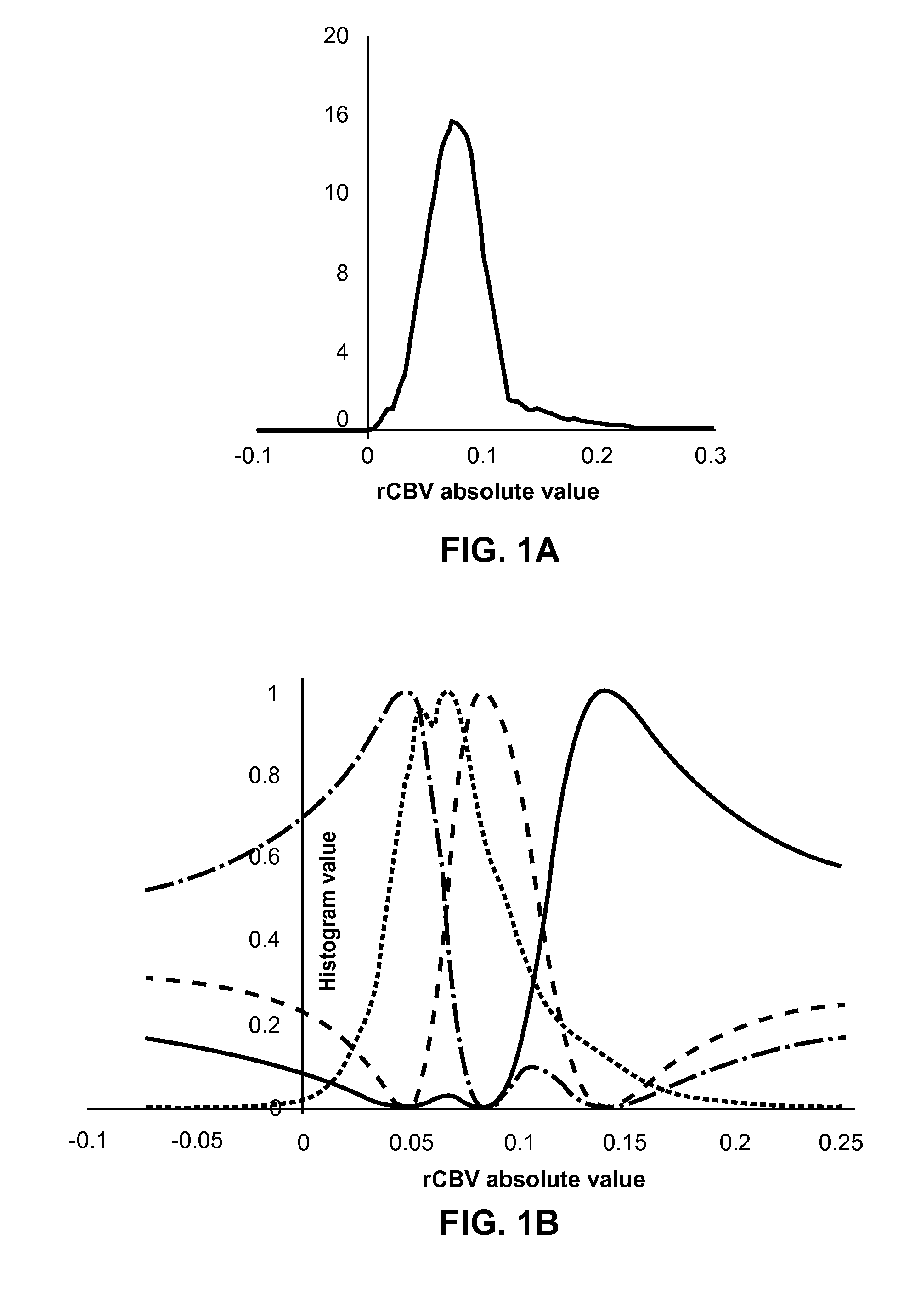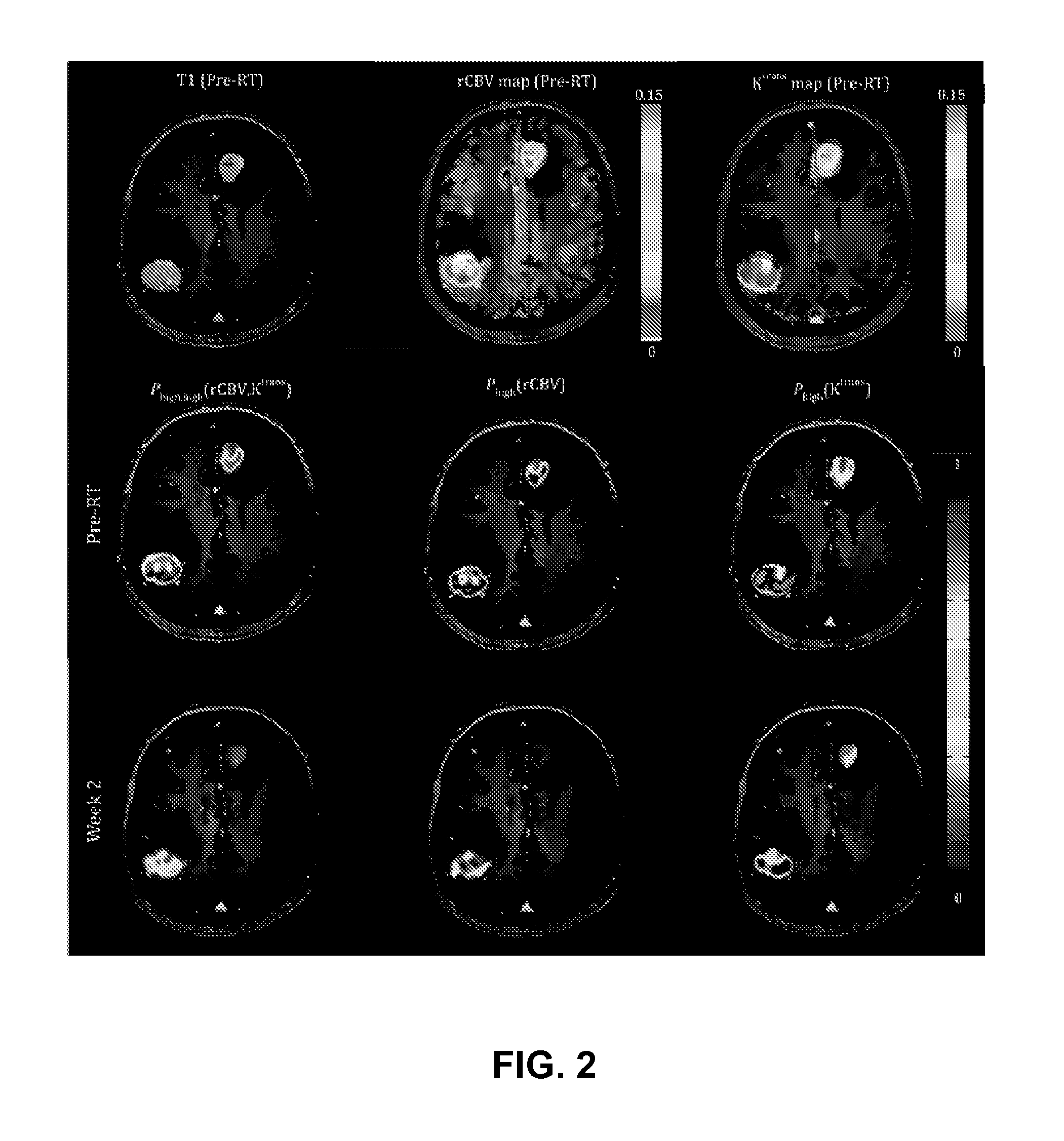Subvolume identification for prediction of treatment outcome
a subvolume and treatment outcome technology, applied in the field of subvolume identification for prediction of treatment outcome, can solve the problems of inability of existing techniques to effectively discriminate information within tumor images, patient loses the time window for optimal treatment, and inability to effectively identify information within tumor images
- Summary
- Abstract
- Description
- Claims
- Application Information
AI Technical Summary
Benefits of technology
Problems solved by technology
Method used
Image
Examples
experiment 1
[0049]Patient Sample:
[0050]In an example implementation of the techniques described herein, twenty patients (11 women and 9 men, ages 41-76 years) diagnosed with brain metastases were enrolled in a prospective MRI study approved by the institutional review board (Table 1). The histology included melanoma (11), non-small cell lung cancer (6), renal cell carcinoma (1), breast cancer (1), and head & neck squamous cell carcinoma (1). All patients received WBRT with a total dose of 30 Gy in 10 fractions (13 patients) or 37.5 Gy in 15 fractions (7 patients). In addition, thirteen patients received Bortezomib during WBRT as a radiation sensitizer. If a patient had three brain metastatic lesions or less, all lesions were included in this analysis. If a patient had more than three lesions, only the three largest lesions were included. If a patient had more than three lesions larger than 1 cm3, the lesions greater than 1 cm3 were also included. As a total, 45 lesions with a median volume of 1...
experiment 2
[0073]In another example implementation the present techniques were applied to dynamic contrast enhanced (DCE) MRI image data. The implementation used global initiated regularized local fuzzy clustering (GRELFC), similar to the techniques outlined above, to identify abnormal subvolumes of head and neck cancers (HNC) from heterogeneous distributions of tumor blood volume (BV) and blood flow (BF), i.e., from functional image data for assessment of therapy response.
[0074]In operation, BV and BF images, derived from DCE-MRI, of 14 patients with advanced HNC were obtained before chemo-radiation therapy (chemo-RT) and 2 weeks after start of 7-week chemo-RT. The delineated subvolumes of tumors with low BV or BF before and during treatment were evaluated for their associations with local failure. Receiver operating characteristic (ROC) analysis was used to assess performance of the method for prediction of local failure of HNC. As discussed further, the results showed that the sizes of the ...
experiment 3
[0115]Using the data gathered from Experiment 1, the following steps of the PCA technique were employed.
[0116]Pre-Processing; DCE Curves Normalization:
[0117]the dynamic curve at each voxel represents the temporal changes in signal intensity after the contrast injection. The signal intensity change AS from pre (baseline) to post contrast is calculated as following:
ΔS(t)≡s(t)-soSo(12)
where S(t) and So represent signal intensities of a DCE curve at times t and 0 (the time of contrast injection), respectively. Note that AS(t) is proportional to AR1, the change in the longitudinal relaxation rate, as long as TR×R1<<1. To account for the individual hemodynamic response to contrast, AS was normalized at each voxel using the peak of the arterial input function, AIFmax, obtained during the same scan as:
ΔSN(t)=ΔS(t)·1AIFmax(13)
[0118]An arterial input function can be determined from a region of interest (ROI) in a large artery (e.g., carotid artery, etc.) manually, semi-automatically or automa...
PUM
 Login to View More
Login to View More Abstract
Description
Claims
Application Information
 Login to View More
Login to View More - R&D
- Intellectual Property
- Life Sciences
- Materials
- Tech Scout
- Unparalleled Data Quality
- Higher Quality Content
- 60% Fewer Hallucinations
Browse by: Latest US Patents, China's latest patents, Technical Efficacy Thesaurus, Application Domain, Technology Topic, Popular Technical Reports.
© 2025 PatSnap. All rights reserved.Legal|Privacy policy|Modern Slavery Act Transparency Statement|Sitemap|About US| Contact US: help@patsnap.com



